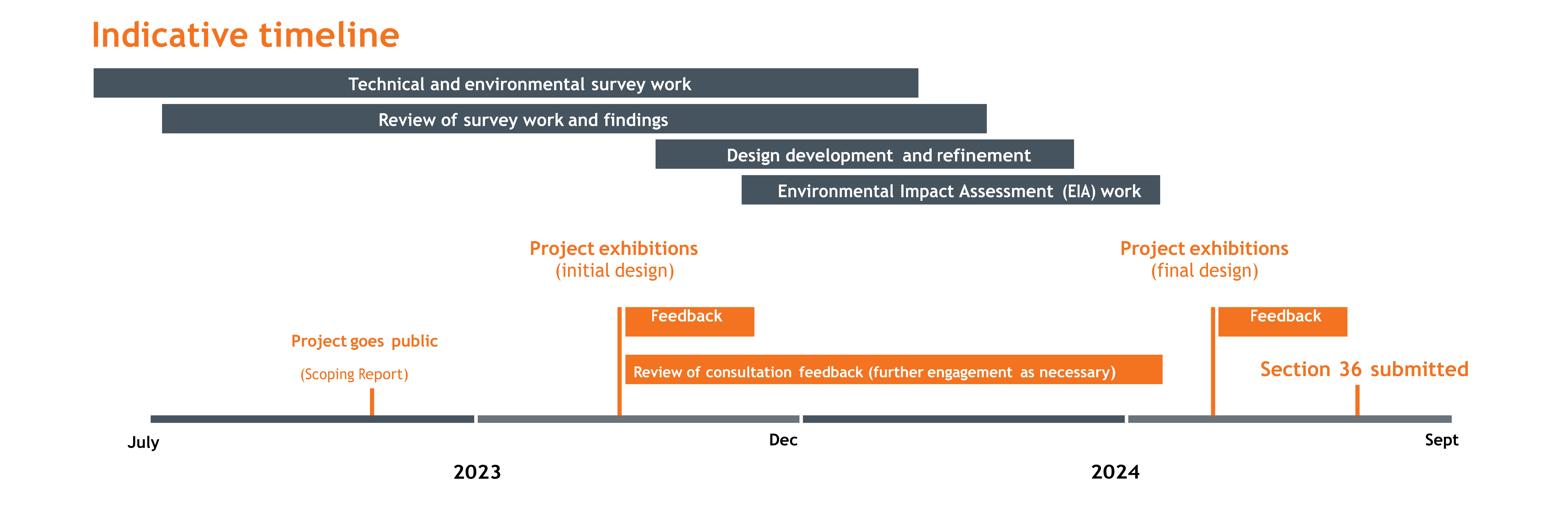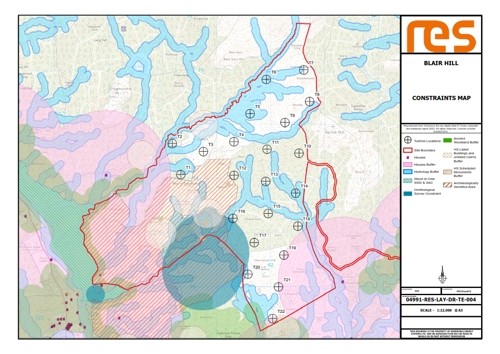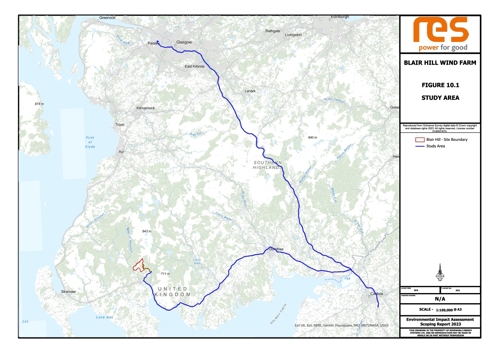Public Exhibitions
RES is in the early stages of exploring the potential for a wind farm located approximately 6km1 north of Newton Stewart, Dumfries and Galloway.We are keen to engage with the local community and as part of our pre-application consultation, in October 2023, we held public exhibitions in the local area to enable people to find out more about the proposal and provide us with their views. RES staff were on hand to answer any questions or queries, and comment forms were available to gather feedback.
The public exhibitions initiated a consultation period being run by RES to gather comments on the proposal. The closing date for comments was Friday 20th October 2023. Comments will still be accepted after this date but may not be considered in relation to the design development. Please contact us for more information.
Please note that comments submitted to RES at this time are not representations to the determining authority (Scottish Government’s Energy Consents Unit). There will be an opportunity to submit representations to the determining authority should an application be made.
About RES and RES in Scotland
RES is the world’s largest independent renewable energy company.
RES has been at the forefront of wind energy development for over 40 years and delivered more than 23GW of renewable energy projects worldwide. We employ more than 2,500 passionate people across the globe and are active in 14 countries, working across onshore and offshore wind, solar, energy storage, green hydrogen, transmission and distribution.
Sustainability lies at the core of our business activity and values, and we have been leading efforts to create a future where everyone has access to affordable zero carbon energy. The 23GW of green energy that we have developed and/or constructed offsets more than 21 million tonnes of carbon every year.
RES is a privately-owned company with a proud history in Scotland. We grew out of Sir Robert McAlpine, a British family-owned firm with over 140 years of experience in construction and engineering including the Glenfinnan Viaduct in the Highlands and the Emirates Arena and Sir Chris Hoy Velodrome in Glasgow. From our Glasgow office we have been developing, constructing and operating wind farms in Scotland since 1993.
We have developed and/or built 21 wind farms in Scotland, with a total generation capacity of 597MW, including Solwaybank Wind Farm near Langholm. We were also involved in the 11-turbine Glenchamber Wind Farm near New Luce, which we now operate. Our work with local contractor Luce Bay during construction of the wind farm, saw more than £8 million invested in the local economy providing employment on site for 45 local people.
The Need for Onshore Wind
National Development
We are in a climate emergency, nature crisis, cost of living crisis and face issues with security of energy supply. Onshore wind can address all of these. This is recognised by the Scottish Government’s National Planning Framework 4 (NPF4) which was published in February 2023. It is Scotland’s long term spatial strategy and categorises onshore wind projects with a generating capacity in excess of 50MW as National Development. In principle it supports all forms of renewable energy generation including onshore wind. There are national targets for reaching Net Zero by 2045 and installing 20GW of onshore wind by 2030.Low-cost electricity
Onshore wind, alongside other renewable technologies, are the cheapest form of electricity generation2. It can be deployed quickly and delivered at lower costs than hydro, marine technologies, and nuclear. If consented, the Blair Hill Wind Farm scheme would be capable of generating enough clean, low-cost renewable electricity for more than 150,000 homes3 each year, based on the preliminary design presented at this exhibition. With the rising cost of living and climate change emergency, it is imperative that we deliver electricity efficiently and at the lowest cost to the consumer.
Energy Security
Wind energy is a free and inexhaustible resource which has an important role to play as part of a balanced energy mix. It increases energy security by reducing our reliance on imports and builds our resilience to sudden fossil fuel price fluctuations or the uncertainty of global markets. Advancements in energy storage solutions will also help capture excess energy generation. The current Blair Hill Wind Farm proposal also includes a 100MW output battery storage facility to help maximise the efficiency of the site and further contribute to energy security.
Improved performance and output
Turbine technology has advanced considerably in recent years, meaning that turbines are now taller and more efficient which enables them to generate a significantly greater amount of renewable electricity per turbine. Modern taller turbines provide more electricity, which helps address the climate emergency, cost of living crisis, and security of energy supply.
The 250m turbines proposed at Blair Hill would allow for far greater benefits in terms of renewable electricity generation per turbine than smaller turbines would. The turbines currently under consideration for Blair Hill would have a generating capacity of 6.6MW each. Each turbine would have the capacity to generate enough clean electricity for around 6,800 homes. By comparison, a 100m turbine would have a generating capacity of around 2.3MW, enough to power approximately 1,800 homes.
Net zero carbon targets
A climate emergency was declared by the UK Government and the Scottish Government in 2019. The UK Government has set a legally binding target for reducing greenhouse gas emissions to net zero by 2050 and the Scottish Government has a net zero target of 2045. Renewables, and specifically onshore wind, will play an important role in helping achieve these targets.
To support net zero delivery across all sectors, including heat, transport and industrial processes, which are currently heavily reliant on fossil fuels, it is expected that there will be a substantial increase in demand for electricity in the coming decades. National Grid’s Future Energy Scenarios4 forecast that Scotland’s peak demand for electricity will at least double within the next twenty years. This will require a substantial increase in installed capacity across all renewable technologies, including onshore wind.
Scotland currently has around 9.3GW of installed onshore wind capacity. The Scottish Government has set a target of 20GW of onshore wind by 2030 in order to help meet their legally-binding net zero targets. This is a substantial increase and will require significant deployment of new onshore wind projects in order to meet this extra demand for green, zero-carbon electricity.
About the Project
We are seeking your views on the preliminary design, which has been informed by initial technical and environmental surveys, for our Blair Hill Wind Farm proposal.The proposed Blair Hill Wind Farm is located approximately 6km north of Newton Stewart, Dumfries and Galloway. The site was chosen because it has good wind resource, few ecological constraints, straightforward access and is close to a viable grid connection. It is also identified in the Dumfries and Galloway Council Local Development Plan as being an area with potential for wind farm development.
Click on image to enlarge
Based on our initial studies, the wind farm would comprise up to 22 turbines, each with a maximum height of 250m, resulting in an overall site generating capacity of 145MW. Turbine technology has advanced considerably in recent years, meaning that turbines are now taller and more efficient which enables them to generate a significantly greater amount of renewable electricity per turbine. If consented, Blair Hill would be capable of generating clean, low-cost renewable electricity for around 150,000 homes each year.
A battery storage facility is also proposed with a power output of around 100MW and a storage capacity of around 200MWh to help increase the flexibility and generation opportunities of the site.
In August 2023, we submitted a Scoping Report to the Scottish Government’s Energy Consents Unit (ECU) which sets out and seeks feedback on the proposed scope of environmental assessment work. Consultee feedback to the Scoping Report continues to be reviewed and any necessary changes made to the proposed scope of environmental and technical work.
Detailed Environmental Impact Assessment (EIA) studies and surveys will continue to be undertaken over the coming months to inform the design. The findings from this EIA work, together with feedback from the local community and stakeholders will be considered as part of the design development.
The Blair Hill Wind Farm proposal will have an installed generating capacity greater than 50MW. As such, the application for planning consent will be submitted by RES to the Scottish Government’s Energy Consents Unit under Section 36 of the Electricity Act 1989 (the Electricity Act) and determined by Scottish Ministers. Dumfries and Galloway Council will be a statutory consultee in the process. We currently expect to submit the Section 36 application around summer 2024.
Indicative Timeline

Design Layout and Infrastructure
The drawing to the right shows the proposed site layout at this early stage of the project.
This design is based on the constraints that have been mapped so far and are explained in the Environmental Considerations section below.
There is a lot of work still to do over the coming months, and the design will be developed and refined during this time in response to both the findings from technical and environmental survey work as well as consideration of feedback from stakeholders and the local community.
Feedback at this early stage has the potential to influence the design and improve the overall quality of the planning application. Please contact us if you have questions about the design or ideas for ways in which it could be improved.
Environmental Considerations
As part of the planning process RES will undertake an Environmental Impact Assessment (EIA). The purpose of an EIA is to identify any significant potential effects of a development on the environment and, where applicable, identify mitigation measures to avoid or reduce potential effects. It also identifies opportunities for restoration and enhancement. The EIA for Blair Hill Wind Farm will include the following assessments:Ecology
The non-avian Ecology Impact Assessment will involve a range of studies including habitats, protected species, notable species (e.g. national and European Protected Species) and locally protected species. Further habitat and species assessment work will be undertaken over the coming months as the design develops and infrastructure siting is refined.
Ornithology
Avoiding impacts on bird species, wherever possible, is an important factor in the design of the site. Already, we have commissioned over 500 hours of baseline ornithological survey work over the last two years during breeding and non breeding seasons to build our understanding of the species on site. Surveys have included flight path activity, breeding behaviour and winter walkover surveys.
Shadow flicker
Shadow flicker is a phenomenon where, under certain circumstances of geographical position and time of day, the sun may pass behind the rotors of a wind turbine and cast a shadow over neighbouring properties.
When the blades rotate, the shadow flicks on and off. It only occurs inside buildings where the flicker appears through a narrow window opening.
The Blair Hill Wind Farm proposal is being designed in a way that will minimise any potential for shadow flicker. Shadow flicker can be easily modelled and mitigated in a number of ways (e.g. shadow detection technology on relevant turbines to create a shutdown timetable if necessary).
Cultural Heritage
The cultural heritage of an area comprises archaeological sites, historic buildings, inventoried gardens and designed landscapes, inventoried battlefields and other historic environment features. The setting of an asset within the wider landscape may contribute to its cultural heritage significance.
There are four designated heritage assets within the site boundary area but there a further 100 non-designated heritage assets which have local importance. The monuments within in the site are The Thieves, Standing Stones (SM1044), Nappers Cottage, Chambered Cairn (SM5676), Drumfern, Stone Circle and Cairn (SM1019) and
Dalvaird, Cairn (SM1015), which date to the Neolithic and Bronze Age.
The Cultural Heritage Impact Assessment will identify cultural heritage assets that may be subject to significant impacts, from the proposed wind farm both on the site and within 10km of the proposed turbines.
A high-level appraisal has been carried out in relation to Scheduled Monuments, Listed Buildings, Inventoried Gardens and Designated Landscapes and Inventoried Battlefields which have been identified
within the vicinity of the site. These include remains of Garlies Castle (SM7916) and Cairnsmore of Fleet, Cairn (SM2316) to the south-west. Potential impacts will be assessed and a programme of mitigation proposed where appropriate.

The Thieves Standing Stones, Blair Hill
Hydrology and hydrogeology
The Blair Hill proposal could have the potential to cause changes to the baseline hydrological and hydrogeological conditions on the site, and the receiving water environment, and as such the EIA will seek to identify sensitive water environment features, assessing potential impacts and proposing mitigation where required.Should any significant impacts be identified as part of the EIA process, appropriate mitigation will be proposed. Mitigation seeks, first, to avoid adverse impacts and, where impacts are unavoidable, to reduce the significance of residual effect to an acceptable level.
Noise
Wind farm noise in many circumstances may be inaudible or effectively “masked” by the background noise already present in the surrounding environment. We take care to ensure noise levels from wind turbines are within recommended limits and comply with planning policy.
We will shortly be commissioning a range of background acoustic studies at selected properties in the local area which will be agreed with Dumfries and Galloway’s Environmental Health Officer. The surveys will measure the acoustics at different times of the day and night in order to establish a baseline. The results of the background sound survey will inform the setting of the noise limits for the operation of the wind farm.
The acoustic impact of the wind farm will be modelled, and the output of this modelling work will be presented in the Acoustics chapter of the Environmental Impact Assessment Report (EIAR) which will accompany the planning application.
The Acoustics chapter of the EIAR will demonstrate that RES has considered all appropriate measures in the design, construction and operational phases of the wind farm to minimise the acoustic impact.
Aviation lighting
The turbines proposed for Blair Hill are above 150m in height and will therefore require aviation lighting so that the turbines are visible to aircraft.
We will be consulting with the Civil Aviation Authority, local airports, the Ministry of Defence and any other relevant consultees over the coming months to agree a lighting strategy with them.
It is worth noting that not all turbines are likely to be required to be lit - for example, lighting may just be required on outermost turbines. Furthermore, the red aviation lighting is designed to focus the light across and upwards for the attention of aircraft rather than downward to those at ground level.
There are also variations in the intensity of the lighting with lower levels required in good visibility and higher levels required in cloudy or foggy weather. In some instances, infra-red lighting may be possible which is invisible to the naked eye. The proposed lighting strategy will be presented in the planning application.
Traffic and Access
Traffic is one of the key considerations when selecting a potential wind farm site, particularly with regard to the turbine deliveries.
The delivery route for turbine components is expected to be via the M74 to Carlisle where they will take the A75 before taking the A712 to the site access. This route avoids Newton Stewart.
Safety is the key consideration and RES will be undertaking a detailed swept path analysis of the turbine delivery route, as well as careful assessment of the main site access options. The preferred access point and turbine delivery route are shown on the map to the right.
Over the next few months, we will consult with the local authority (Transport Scotland and BEAR Scotland), the emergency services, the local community and other relevant bodies on our transport plans.
A transport assessment will be undertaken as part of the Environmental Impact Assessment (EIA) process and, if the wind farm is given consent, a detailed Traffic Management Plan will be agreed with the roads authority and the police.
Wherever reasonably practicable we will use materials available on site and source construction materials locally in order to help reduce traffic movements.
What Would the Wind Farm Look Like?
We have produced wirelines and photomontages based on the preliminary layout to help give an impression of what the wind farm could look like from different viewpoints in the area. Click on the links below to view.
Tip Height Zone of Theoretical Visibility (ZTV) - 15km
The Zone of Theoretical Visibility (ZTV) map below illustrates the theoretical extent of where turbines will be visible from within a 15km area, assuming 100% visibility.
The ZTV is screened and as such takes into account landscape artefacts such as trees, woodland and buildings.
Maximising Local Benefit
A power for good
RES seeks to be a power for good in communities that neighbour our projects by working openly and constructively to ensure tangible local benefits. We believe that onshore wind should provide direct, lasting benefits to local communities and there are a number of ways that this can be achieved.We take a tailored approach and work directly with the community to understand how the wind farm could support the local area and help to secure long-term economic, social and environmental benefits. This approach will help to deliver a tailored community benefits package, that would be worth £5,000 per MW (or equivalent) of installed capacity per annum, that is aligned with the priorities of the local
community and could, for instance, provide funding for projects that sit outside the parameters of a traditional application-based fund.
As part of this exhibition and consultation period we are seeking feedback on your ideas for local benefits and priority projects that you would like to see supported or delivered in your community from Blair Hill Wind Farm, should it receive consent. Some examples from other communities that we’ve worked with include:
• biodiversity initiatives
• business start-up initiatives
• apprenticeships/educational schemes
• improvements to village halls
• funding for schools and local community groups
• community defibrillators
• improved broadband provision
• electric car charging points
• improvements to local footpaths and/or signage
• funding for local groups and organisations
Any feedback which may tie into the design is particularly important for us to capture at this early stage so that it can be considered in relation to the development and refinement of the scheme over the coming months. It is important to note that voluntary community benefits are not a material planning consideration.
Local Electricity Discount Scheme
Our unique Local Electricity Discount Scheme (LEDS) seeks to deliver direct and tangible benefits to people living and working closest to RES’ operational wind farms.
Developed in response to research and feedback from local communities around RES’ operational wind farms, LEDS offers an annual discount to the electricity bills of those properties closest to a participating RES wind farm. If this is something that you are interested in as a potential part of a tailored community benefits package at Blair Hill, please note this in your written feedback to RES.

Working with the local supply chain
Some of the most direct and meaningful benefits that can be delivered from a project like this are jobs and employment for local businesses and contractors, in addition to the use of local services and amenities, all of which can generate a significant amount of inward investment within the area.
RES is committed to ensuring that, wherever reasonably practical, local contractors are used in all aspects of wind farm development. In order to maximise the opportunities from the Blair Hill Wind Farm proposal we are looking to build our knowledge of the local skills and capabilities within the area.
Expenditure in the local economy during the development, construction and operation of wind farms varies from project to project due to various factors including project size, project duration, and the availability of local suppliers. In recent years, RES has seen typical spend with local stakeholders, suppliers and service providers in the region of £279,000 per wind turbine during the development, construction and first year of project operation. In some cases, it has been possible to significantly improve on this number.
The Blair Hill Wind Farm proposal is predicted to deliver approximately £6 million of inward investment to the area in the form of jobs, employment, and use of local services during the development, construction and first year of operation.
If you’re a local business, or know one, interested in getting involved in onshore wind please contact us.
Glenchamber Wind Farm – case study
Glenchamber, an 11-turbine wind farm located in Dumfries and Galloway has an installed capacity of 27.5MW and began operating in 2016. In keeping with our commitment to maximise economic benefit to the local area, the civil engineering contractor chosen for Glenchamber was Luce Bay Group who are based just 8 miles from the wind farm. RES’ work with Luce Bay saw more than £8 million invested into the local economy and provided employment for 45 local people.

Shared Ownership
RES is interested to understand whether there is any appetite from the community in exploring the potential for shared ownership in the wind farm. If this is something that interests you, please put this in your comments form.Local Energy Scotland is the independent body that manages the Scottish Government’s Community and Renewable Energy Scheme (CARES). To find out more about the scheme visit: https://localenergy.scot/hub/shared-ownership/.
2 https://assets.publishing.service.gov.uk/media/6556027d046ed400148b99fe/electricity-generation-costs-2023.pdf
3 The homes figure has been calculated by taking the predicted annual electricity generation of the site (based on RES assessments Blair Hill has a predicted capacity factor of 42.8%) and dividing this by the annual average electricity figures from the Department of Business, Energy and Industrial Strategy (BEIS) showing that the annual UK average domestic household consumption is 3,509 kWh (Dec 2022).
4 htttps://www.nationalgrideso.com/future-energy/future-energy-scenarios






